MARKET OVERVIEW
The Global Aircraft Tire Pressure & Brake Temperature Monitoring System market is a crucial element in the aviation industry for enhancing operational safety and efficiency. This market is invested in advanced solutions that give real-time functionality parameters regarding tire pressures and brake temperatures to ensure airworthiness of the aircraft during landing, take-off, and taxiing. Airliners, maintenance teams, and aircraft manufacturers will be reliant on these technologies in the future to avert tire blowouts, brake failures, and other safety-related hazards arising from improper pressure and excessive heat situations.
With advancements in the aviation technology, interconnectivity of aircraft systems will ably drive the development of integrated monitoring solutions. The Global Aircraft Tire Pressure & Brake Temperature Monitoring System is thereby offered as a solution with highly accurate sensors and software-driven analytics to allow airlines to monitor and manage tire pressure and brake temperature in real time. Such monitoring systems assist in the timely diagnosis of anomalies before they can mature to critical failures, thus safeguarding passengers and optimizing maintenance costs. Sensor technology and data analytics will evolve further to fine-tune and render these systems crucial for conducting aircraft operations.
In order to satisfy rigorous safety regulations for aviation, aircraft makers and fleet operators will prioritize the adoption of these monitoring solutions. The Global Aircraft Tire Pressure & Brake Temperature Monitoring System market will witness some incremental technological improvements with the introduction of newer safety mandates and performance standards by aviation authorities. Automation will apply to monitoring methods, replacing manual inspections and reducing human error while assuring more accuracy. Predictive maintenance measures will permit airlines to resolve possible predicaments before they escalate into anything that may delay a flight or incur expensive repair bills.
The efficiency of aircraft operations will directly depend on the accuracy of tire pressure and brake temperature data. The Global Aircraft Tire Pressure & Brake Temperature Monitoring System market offers solutions that enhance fuel efficiency, landing accuracy, and brake service life. Under-inflated or over-inflated tires can jeopardize aircraft stability; excessive temperatures on the braking system can cause brake failure. Continuous monitoring in these areas will help ensure smooth landings and take-offs while extending component life.
Sensor miniaturization and wireless communication technologies will revolutionize the Global Aircraft Tire Pressure & Brake Temperature Monitoring System market. Greenfield systems will dine seamlessly inside the wider aircraft health monitoring platforms, which will provide predictive conclusions empowering overall aircraft performance.
Aircraft safety and maintenance regulations will keep changing due to global air travel demand changing the face of aviation. The Global Aircraft Tire Pressure & Brake Temperature Monitoring System market will be of paramount importance in making this change through intelligent monitoring systems, keeping with the aviation industry's trend toward automation and data-driven decision-making. The technologies will be developed by the involvement of regulators, aerospace engineers, and airline operators so that aircraft systems can be reliable under all operational conditions.
The Global Aircraft Tire Pressure & Brake Temperature Monitoring System market will continue to remain a focal point in aircraft maintenance strategies, with sensor technology, data applications, and wireless communication continuing to evolve its impact on aviation safety. Adoption of these monitoring solutions will continue to grow with airlines and manufacturers focusing on enhancing performance, reducing maintenance costs, and complying with evolving legislative mandates.
Global Aircraft Tire Pressure & Brake Temperature Monitoring System market is estimated to reach $412.4 Million by 2032; growing at a CAGR of 7.0% from 2025 to 2032.
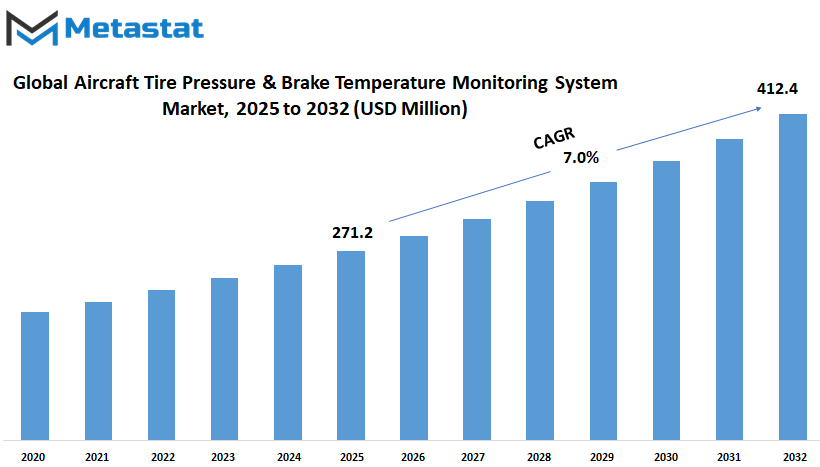
GROWTH FACTORS
The current aviation market is demonstrating high growth momentum in terms of technologies focusing on Aircraft Tire Pressure & Brake Temperature Monitoring System Market. Monitoring systems are vital for flight safety and the efficient operationalization of an aircraft. There exist several critical drivers that contribute to this market.
One of the major drivers is the safety regulation introduced by aviation authorities worldwide. Most regulatory bodies require regular monitoring and maintenance of aircraft components, such as tire pressure and brake temperatures, to avoid accidents through failures of these components. Advanced monitoring systems enable real-time tracking so as to be compliant with these safety standards, thus contributing significantly to the growth of the market.
Technological advancement has also contributed greatly to the drive in propelling the growth of the market. With improved state-of-the-art sensors and real-time data analytics, today's monitoring has been more accurate and reliable. The adoption of wireless and Internet of Things (IoT) connectivity allows seamless data integration into sub-systems and further insights into the whole aircraft health. It enables monitoring remote events and real-time alerts, thus allowing for rapid response to fault events from ground crews.
However, several obstacles may hinder the growth of this market. Installation and maintenance costs of these advanced systems may act as a big hurdle, especially for small airlines or even older fleets in the market. These systems require high-end sensors and compatibility with existing aircraft systems, which are very costly to install and maintain. The requirement for routine calibration and the possibility for system upgrades have added operational costs.
Though there are challenges for the upgrading and innovation of the monitoring systems, there are still promotions. The dramatic increase of predictive maintenance in the aviation industry, which provides fast handling of potential problems before they materialize into failures, continues to boost the market. More and more airlines are investing in such systems to enable smooth and efficient operations, thereby stimulating interest and demand for advanced monitoring solutions.
In summary, the manufactured systems for aircraft tire pressure and brake temperature monitoring are expected to grow at a fast pace. The regulations promoting stringent safety measures and technological advances have solved most costs of investments, which can be high. Predictive maintenance is another promising opportunity, indicating a future where these systems are absolute in aviation, ensuring air travel is safe while efficient.
MARKET SEGMENTATION
By Type
The Global Aircraft Tire Pressure & Brake Temperature Monitoring System market shall venture forth into growth due to advancements in aviation technology and more stringent safety regulations. Airlines and aircraft manufacturers target improvements in safety, efficiency, and maintenance processes. Thus, the demand for advance monitoring systems rises. As the aviation industry grows, the need for reliable monitoring systems that track tire pressure and brake temperature becomes increasingly important.
The monitoring systems will help in the timely detection of warning signs indicative of pressure or excessive heat buildup and will prevent potential failures which, over an extended period of such warning systems, will help reduce accident incidences and improve aircraft overall performance. However, with sensor technology and data analytics keeping pace with advancements, predictive maintenance will supersede reactive repairs. This saves airlines money and produces environments with lower downtime and operational costs, to the benefit of both passenger safety and satisfaction.
The Global Aircraft Tire Pressure & Brake Temperature Monitoring System Market is segmented by type: temperature monitoring, pressure monitoring, and nitrogen monitoring. Temperature monitoring keeps a check that the brake components do not go to the temperature at which they overheat; thus, there is a possibility of brake failure in total efficiency. Pressure Monitor helps maintain the proper amount of tire inflation recommended for the aircraft to ensure safe landings and take-offs. Good tire inflation ensures better performance and longer life for the aircraft’s landing gear. Nitrogen monitoring is essential because nitrogen-filled tires lose lesser inflations as it is not dramatically impacted by temperature, contributing towards a stable and reliable operation.
However, most times, AI and automation penetrate these systems in order to produce more developed diagnostic capabilities and adjustments in real-time into these systems. Sensors will be installed in the planes that communicate directly to ground maintenance crew. Thus, proactive measures will be taken before the escalation of any issue, leading to better turnaround times on aircraft and overall efficiency. Additionally, such advancements that create eco-friendly systems will lead to developments towards waste minimization. This will contribute towards improving sustainable practices in aviation.
The growing emphasis on safety regulations and increasing air traffic will continue driving the Global Aircraft Tire Pressure & Brake Temperature Monitoring System market. Technology progresses, and these systems become not only smarter but also more accessible for both commercial airlines and smaller operators. For the future of aviation, they ensure optimal performance and reduced risks.
By Application
The global aircraft tire pressure and brake temperature monitoring system market will witness growth with the advances in aviation technology, which have continuously played a crucial role in shaping the future of air travel. Safety is still the primary consideration; hence monitoring tire pressure and brake temperature is important in preventing possible accidents and ensuring smooth operations. Airlines and aircraft manufacturers are working towards enhancing these systems to achieve operational efficiency, reduce maintenance costs, and increase the lifespan of these critical components.
One significant driver for this market is the consequential increase in the number of aircraft worldwide. And the more aircraft are flying, the greater the demand for reliable monitoring systems, which should recognize problems before they escalate. These monitor failures on tires or brakes should minimize. Even airlines want to avoid a situation where their maintenance problems can lead to flight delays, cancellations, or safety issues. Therefore, by applying advanced monitoring technologies, real-time information will be provided to assist airlines in making timely decisions and planning maintenance of the aircraft.
The design and extent of application of the system rules over its market accessibility. Transport-type aircraft hand cargo for quite long ranges, hence the monitoring systems are necessary for safely loading and unloading heavy cargo. Regulation of tire pressure and brake temperature within required limits will ensure the functionality of these planes when landing and taking off under heavy cargo loads. Safety and comfort are primary considerations for passenger aircraft. Maintenance of monitoring systems prevents the risk of sudden technical failures, ensuring passengers reach their destinations safely; other types of aircraft, both military and private jets, also benefit from these systems, as they must manoeuvre in varied circumstances where strict monitoring would become paramount.
Through further innovations for the future, the market shall continue. The use of smart sensors and automation will provide a better working of these systems. New technologies might evolve wherein the airplane can forecast or predict failures very much ahead of time, thus minimizing any downtime and maximizing the efficiency. The ability to monitor data remotely will also be enhanced using wireless connectivity, therefore enabling ground teams to take emergency measures once a particular issue arises. As sustainability becomes paramount, these advanced monitoring services would enable the reduction of fuel consumption by ensuring optimum tire and brake performance.
With the ongoing expansion of air travel, the demand for more advanced monitoring systems will only increase. These will become the focus of airlines and manufacturers as they work on developing solutions that would offer greater returns in terms of efficiency, accuracy, and affordability. Such improvements will, in turn, vastly improve safety and pave the way for air travel to be a pleasant and reliable experience for passengers and cargo across the globe.
|
Forecast Period |
2025-2032 |
|
Market Size in 2025 |
$ 271.2 million |
|
Market Size by 2032 |
$412.4 Million |
|
Growth Rate from 2025 to 2032 |
7.0% |
|
Base Year |
2024 |
|
Regions Covered |
North America, Europe, Asia-Pacific, South America, Middle East & Africa |
.
REGIONAL ANALYSIS
The aircraft tire pressure and brake temperature monitoring systems market is going to do well across the globe. Most regions will play an important role in shaping the future development of this market. Within North America, the US stays at the top, owing to a well-established aviation sector comprising both civilian and military operations. Stringent safety norms and the presence of some of the top aircraft manufacturers go on to foster the proliferation of advanced monitoring systems. Other countries like Canada and Mexico are developing as their aviation industries evolve and safety aspects start being focused on.
Europe paints a heterogeneous picture in itself where countries such as the UK, Germany, France, and Italy emerge out of ranks and advance in aviation. The stiff safety standards of the European Union and green commitments toward carbon emissions propel demand for such advanced monitoring systems. The collaborations of European nations also contributed to this further stimulating best practices in the innovation and integration of these systems into modern designs of aircraft.
The aviation sector in the Asia-Pacific region is also rapidly growing, especially in countries such as China, India, Japan, and South Korea. The Chinese government makes huge investments in airport infrastructure and enhances safety standards, making them adopt advanced monitoring technology. In India, the rise of air travel and the modernization of aviation infrastructure called for a growing need for such systems. Japan and South Korea have very good technology and interests concerning aviation safety; thus, this region is further enhanced in market growth.
Led by Brazil and Argentina, South America is gradually developing its market. With increasing air travel demand and Brazil's active involvement in aircraft manufacturing, an advanced monitoring system is required for safety and efficiency. Argentina's activities for renewing its aviation sector have also helped in the adoption of such technologies.
The demand will substantially stimulate demand in these regions, as safety, efficiency, and technological innovations in aviation will further develop in the aircraft tire pressure and brake temperature monitoring systems. The future will be driven by cooperations, regulatory environments, and technological progress in this market towards ensuring improved safety and performance standards in a globally interconnected aviation economy.

COMPETITIVE PLAYERS
The Global Aircraft Tire Pressure & Brake Temperature Monitoring System market will likely be booming with advancements in technology. As air travel continues to become safer and faster, companies in the sector will keep on focusing on innovations to improve aircraft performance, such as monitoring tire pressure and brake temperature. This is crucial for ensuring safety during takeoff, landing, and taxiing, as any irregularities associated with these can lead to serious consequences. Hence, they are an important part of modern aviation in their providing shorter real-time monitoring systems. As the aircraft technology keeps advancing, the industry is also progressing towards completely automated and highly accurate monitoring solutions.
This increase in the number of commercial and military aircraft globally has compelled companies towards developing advanced monitoring systems that provide accurate and timely data. These systems lower maintenance costs, improve fuel consumption, and increase overall safety. Nowadays detecting problems before they escalate into critical failures has become high on the priority list of airlines and manufacturers. The tide is forcing companies in the industry to invest in R&D to make sure their technology stays at the cutting edge of safety and efficiency.
The contribution of few key players towards the Global Aircraft Tire Pressure & Brake Temperature Monitoring System market makes it unique in terms of innovation and solutions. The names coming to mind regarding this innovation and development of systems include Crane Aerospace & Electronics, Meggitt PLC, Safran Landing Systems, UTC Aerospace Systems, ARi Industries, THERMOCOAX, Tayco Engineering, and HarcoSemco. These industry leaders set out to enhance accuracy of sensor, reduce weight of the system, and provide faster transmission of data to pilots and maintenance crews as real-time information to enable effective decision-making. The competition arising from these companies is further expected to spur advancements leading to the development of smarter, efficient technology.
The future scenarios for this market will depend upon upcoming advancements in the field of artificial intelligence and machine learning. Predictive maintenance will also play an important role because it measures data analysis looking for future possible failures. Aircraft operators will see more reliable systems causing fewer unexpected breakdowns, since now it will be integrated into a wireless means of connecting data.
Regulations tend to get tighter and tighter over time, and as a result, airlines will continue to pour money into these improved monitoring solutions to comply with safety requirements. Adoption rates for these systems will continue to rise as airlines put passenger safety and operational cost-savings first. The better these investments and technological improvements hold out, the fuller the Global Aircraft Tire Pressure & Brake Temperature Monitoring System market will remain in the aviation sector, and it will shape future travel.
Aircraft Tire Pressure & Brake Temperature Monitoring System Market Key Segments:
By Type
- Temperature Monitoring
- Pressure Monitoring
- Nitrogen Monitoring
- Total
By Application
- Transport Plane
- Passenger Plane
- Others
Key Global Aircraft Tire Pressure & Brake Temperature Monitoring System Industry Players
- Crane Aerospace & Electronics
- Meggitt PLC
- Safran Landing Systems
- UTC Aerospace Systems
- ARi Industries
- THERMOCOAX
- Tayco Engineering
- HarcoSemco
WHAT REPORT PROVIDES
- Full in-depth analysis of the parent Industry
- Important changes in market and its dynamics
- Segmentation details of the market
- Former, on-going, and projected market analysis in terms of volume and value
- Assessment of niche industry developments
- Market share analysis
- Key strategies of major players
- Emerging segments and regional growth potential



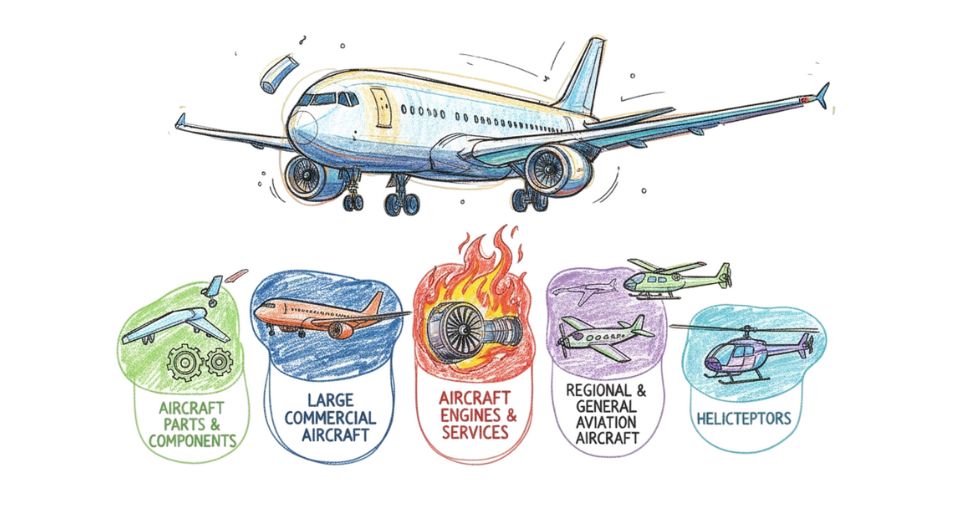
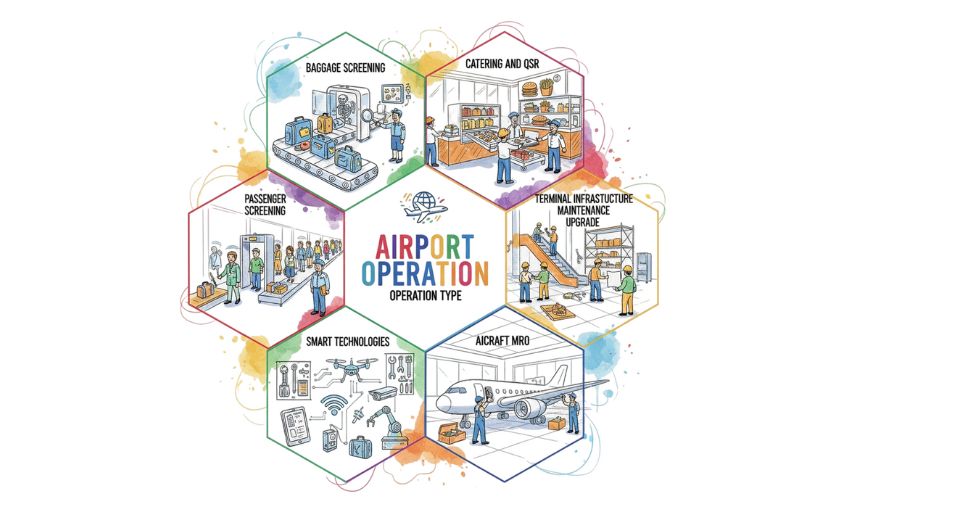

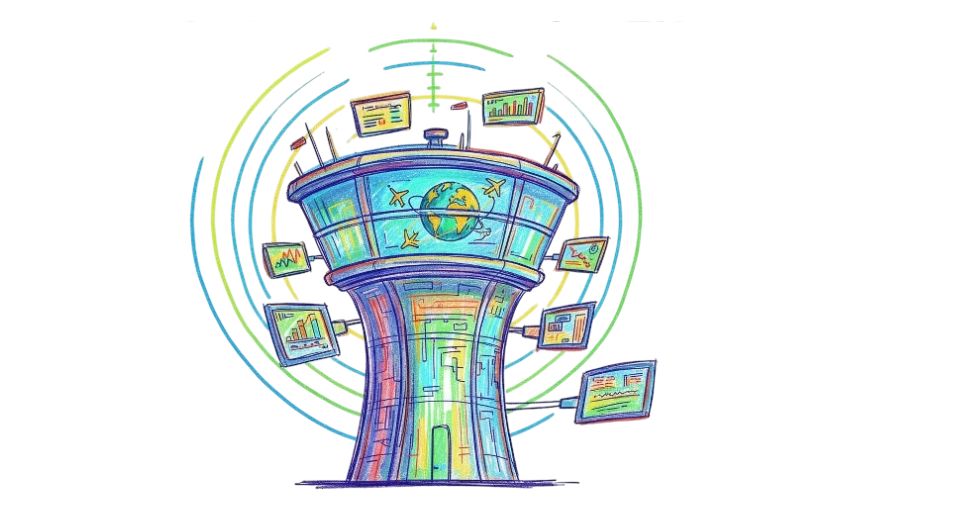
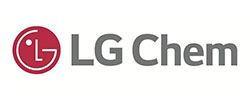

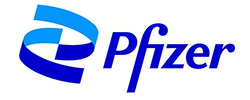




 US: +1 3023308252
US: +1 3023308252






